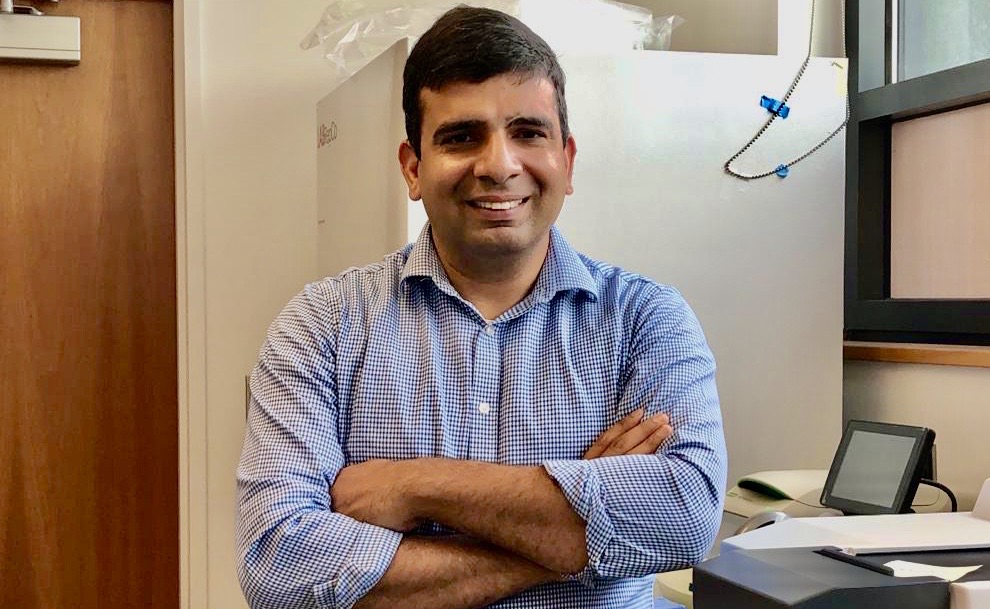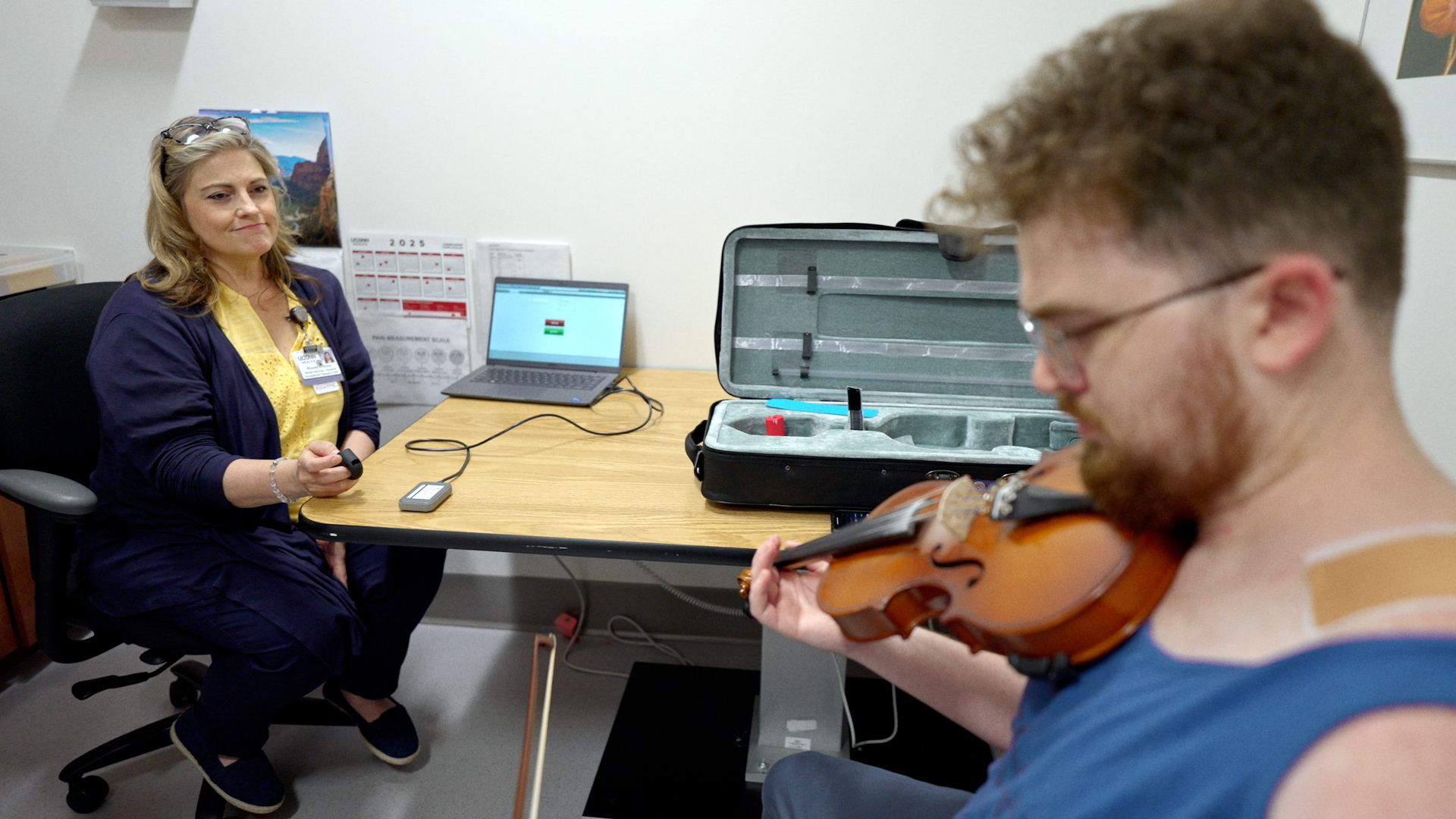Raman Bahal’s research gets to the core of the problem. By looking at the molecular root of cancer and genetic diseases, Bahal, an assistant professor in the University of Connecticut’s School of Pharmacy, develops highly specific and targeted therapies to correct disease-causing mutations.
Bahal began his career studying medicinal chemistry at Punjabi University, where he received his bachelor’s degree and the National Institute of Pharmaceutical Education and Research (NIPER), Mohali, where he earned his master’s degree.
Later in his career while completing his doctorate at Carnegie Mellon University, Bahal’s research moved toward the field of synthetic nucleic acids. Synthetic nucleic acids are chemically modified analogues of DNA or RNA, the genetic material that directs all cellular functions. A single base mutation in DNA, which contains approximately 4 billion base pairs, can cause severe diseases like sickle cell anemia or cystic fibrosis. These genetic mutations also play a significant role in the development of cancer.
Bahal studied peptide nucleic acids (PNAs), a synthetic analogue of DNA or RNA, in the Department of Chemistry at Carnegie Mellon. PNAs can bind to the target DNA or RNA with high specificity and correct disease-causing mutations in the genetic material.
Synthetic nucleic acids offer a promising approach for treatment of a variety of disorders. By studying nucleic acid chemistry, researchers can directly target the DNA at the core of several genetic disorders.
A Trio of Complementary Interests
Bahal’s research interests are trifold: the development of synthetic nucleic acid molecules for correcting genes that cause disorders like sickle cell disease, selectively targeting cancer-causing genes, and establishing efficient delivery system for these molecules. Much of his research is of particular interest for the pharmaceutical industry, which could potentially commercialize these discoveries for future disease therapies.
Bahal’s work on delivery systems for synthetic nucleic acid analogs like PNA is an essential piece of the treatment puzzle. An effective nucleic acid therapy is of no use if it is unable to make its way into the cells where it interacts with the target DNA or RNA.
“Once you make them, you think about how you can explore those molecules,” Bahal says.
One major hurdle for these molecules is to deliver them into targeted organs. An additional challenge for nucleic acids is that more than simply entering the cytoplasm of the cell, they need to enter the nucleus and bind to a specific part of the DNA which is tightly packed into chromosomes.
Bahal also focuses on the application of PNAs for cancer treatment. One of the biggest challenges for cancer treatment is toxicity due to the lack of specificity to target cancer cells without harming other, healthy cells.
Bahal is currently looking at an alternative treatment for pediatric lymphoma as well as glioblastoma, a cancerous brain tumor, using bioactive molecules that specifically target the lymphoma cells, hence reducing overall toxic side effects.
Community and Collaboration
One of the aspects of UConn’s research community Bahal appreciates most is the ease of access it provides to multi-disciplinary collaborators with a broad range of interests and expertise.
“UConn is the place where you can work with people from different backgrounds and collaborate,” Bahal says. “I cherish working in this kind of environment.”
Along with colleagues in the School of Pharmacy, he has collaborated with UConn researchers in the School of Medicine and Department of Materials Science, as well as inter-institutional work with researchers at Harvard, Yale, and beyond.
“There is a wide range of collaborations,” Bahal says. “We don’t want to restrict these tools to just our lab.”
Making it Personal
Bahal’s research is on the frontlines of one of the most exciting possibilities for health research: Precision medicine.
Precision medicine focuses on developing personalized therapies tailored for an individual patient based on their genetic disposition.
“Sequencing technology has made it feasible to think about precision medicine,” Bahal says.
With advances in genetic sequencing technology, scientists can identify the exact nucleic acid sequence of a gene as well as the disease-causing mutation. The disease is not always caused by the same genetic mutation in all patients.
Cancer, for example, can be caused by a series of different oncogenes, cancer causing genes. Not all oncogenes are “turned on” in a patient. If researchers and clinicians could identify the activated oncogenes as the root of the problem, they can implement a substantially effective and targeted therapy to prevent the cancer progression.
From Bench to Bedside
While he did initially consider other career trajectories, by around the third year of his Ph.D. program, Bahal was sure he wanted to go into research.
Bahal says he enjoys the freedom of being a researcher, able to come up with and execute his own ideas as well as pursuing productive partnerships.
“Research keeps me moving,” Bahal says.
One of the most rewarding aspects of Bahal’s role as a professor and advisor is nurturing young researchers. Seeing the work his students do in his lab, Bahal envisions bright futures for them beyond UConn.
“When they go to different places, they can come up with some really great ideas,” Bahal says.
There are always new challenges and avenues to pursue to craft better treatments, making the research in which Bahal’s lab is engaged a wide and exciting field.
As there are a seemingly endless number of diseases in the world, pharmaceutical researchers have an important task before them to find better ways to treat them.
“It’s a fight and a battle you cannot afford to lose,” Bahal says. “I’m preparing these soldiers for the next battle.”
Looking toward the future of his research, Bahal hopes to combine his interests in nucleic acids and nanotechnology to improve chemotherapy resistance in cancer patients.
In theory, combining these two technologies could reduce cancer cell’s ability to mutate to resist chemotherapy drugs, making cancer treatments more effective and decreasing the incidence of chemo-resistant relapse.
Bahal hopes to someday move these therapies from the theoretical shelf into clinical practice where they can help people.
“I want to move it from the bench to the bedside,” Bahal says. “It could do miracles.”



